Tambet Matiisen
Controlling Steering with Energy-Based Models
Jan 28, 2023Abstract:So-called implicit behavioral cloning with energy-based models has shown promising results in robotic manipulation tasks. We tested if the method's advantages carry on to controlling the steering of a real self-driving car with an end-to-end driving model. We performed an extensive comparison of the implicit behavioral cloning approach with explicit baseline approaches, all sharing the same neural network backbone architecture. Baseline explicit models were trained with regression (MAE) loss, classification loss (softmax and cross-entropy on a discretization), or as mixture density networks (MDN). While models using the energy-based formulation performed comparably to baseline approaches in terms of safety driver interventions, they had a higher whiteness measure, indicating higher jerk. To alleviate this, we show two methods that can be used to improve the smoothness of steering. We confirmed that energy-based models handle multimodalities slightly better than simple regression, but this did not translate to significantly better driving ability. We argue that the steering-only road-following task has too few multimodalities to benefit from energy-based models. This shows that applying implicit behavioral cloning to real-world tasks can be challenging, and further investigation is needed to bring out the theoretical advantages of energy-based models.
LiDAR-as-Camera for End-to-End Driving
Jun 30, 2022



Abstract:The core task of any autonomous driving system is to transform sensory inputs into driving commands. In end-to-end driving, this is achieved via a neural network, with one or multiple cameras as the most commonly used input and low-level driving command, e.g. steering angle, as output. However, depth-sensing has been shown in simulation to make the end-to-end driving task easier. On a real car, combining depth and visual information can be challenging, due to the difficulty of obtaining good spatial and temporal alignment of the sensors. To alleviate alignment problems, Ouster LiDARs can output surround-view LiDAR-images with depth, intensity, and ambient radiation channels. These measurements originate from the same sensor, rendering them perfectly aligned in time and space. We demonstrate that such LiDAR-images are sufficient for the real-car road-following task and perform at least equally to camera-based models in the tested conditions, with the difference increasing when needing to generalize to new weather conditions. In the second direction of study, we reveal that the temporal smoothness of off-policy prediction sequences correlates equally well with actual on-policy driving ability as the commonly used mean absolute error.
A Survey of End-to-End Driving: Architectures and Training Methods
Mar 13, 2020



Abstract:Autonomous driving is of great interest to industry and academia alike. The use of machine learning approaches for autonomous driving has long been studied, but mostly in the context of perception. In this paper we take a deeper look on the so called end-to-end approaches for autonomous driving, where the entire driving pipeline is replaced with a single neural network. We review the learning methods, input and output modalities, network architectures and evaluation schemes in end-to-end driving literature. Interpretability and safety are discussed separately, as they remain challenging for this approach. Beyond providing a comprehensive overview of existing methods, we conclude the review with an architecture that combines the most promising elements of the end-to-end autonomous driving systems.
Perspective Taking in Deep Reinforcement Learning Agents
Jul 03, 2019

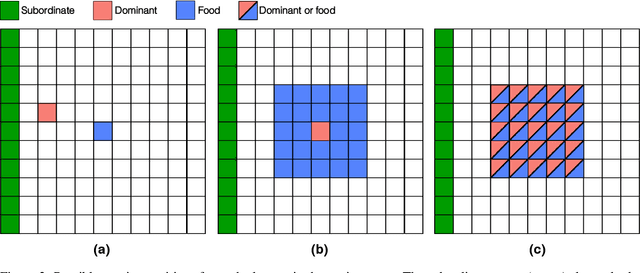

Abstract:Perspective taking is the ability to take the point of view of another agent. This skill is not unique to humans as it is also displayed by other animals like chimpanzees. It is an essential ability for efficient social interactions, including cooperation, competition, and communication. In this work, we present our progress toward building artificial agents with such abilities. To this end we implemented a perspective taking task that was inspired by experiments done with chimpanzees. We show that agents controlled by artificial neural networks can learn via reinforcement learning to pass simple tests that require perspective taking capabilities. In particular, this ability is more readily learned when the agent has allocentric information about the objects in the environment. Building artificial agents with perspective taking ability will help to reverse engineer how computations underlying theory of mind might be accomplished in our brains.
APES: a Python toolbox for simulating reinforcement learning environments
Aug 31, 2018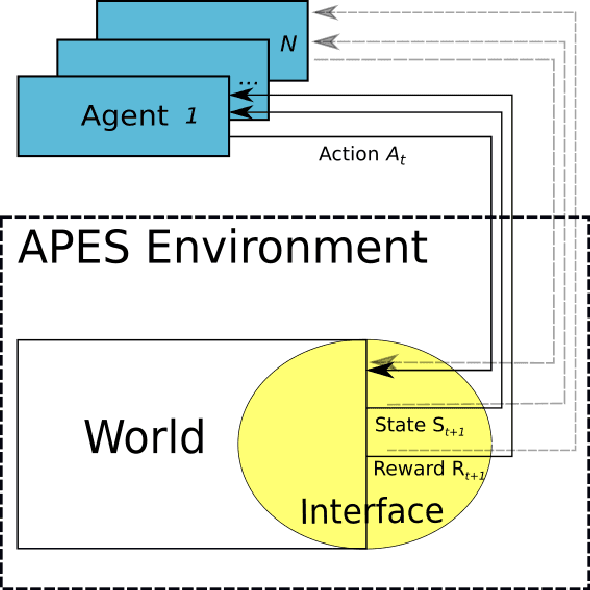
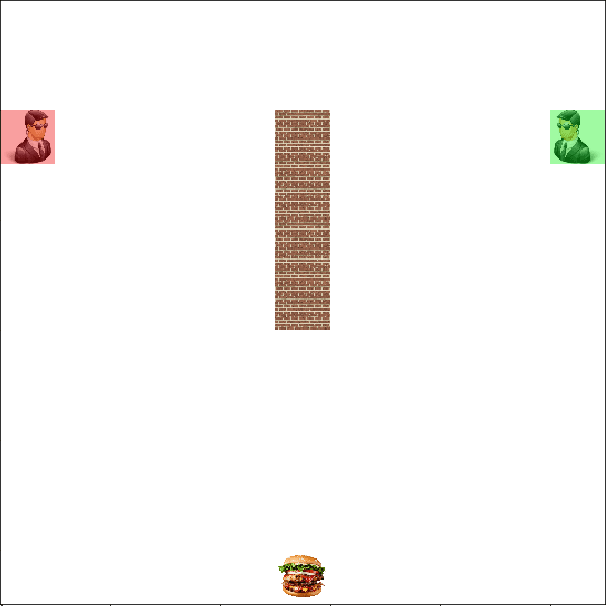

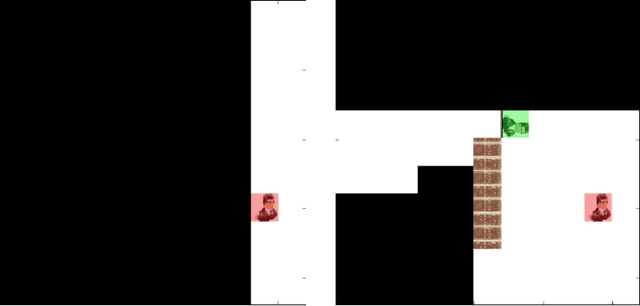
Abstract:Assisted by neural networks, reinforcement learning agents have been able to solve increasingly complex tasks over the last years. The simulation environment in which the agents interact is an essential component in any reinforcement learning problem. The environment simulates the dynamics of the agents' world and hence provides feedback to their actions in terms of state observations and external rewards. To ease the design and simulation of such environments this work introduces $\texttt{APES}$, a highly customizable and open source package in Python to create 2D grid-world environments for reinforcement learning problems. $\texttt{APES}$ equips agents with algorithms to simulate any field of vision, it allows the creation and positioning of items and rewards according to user-defined rules, and supports the interaction of multiple agents.
Do deep reinforcement learning agents model intentions?
May 21, 2018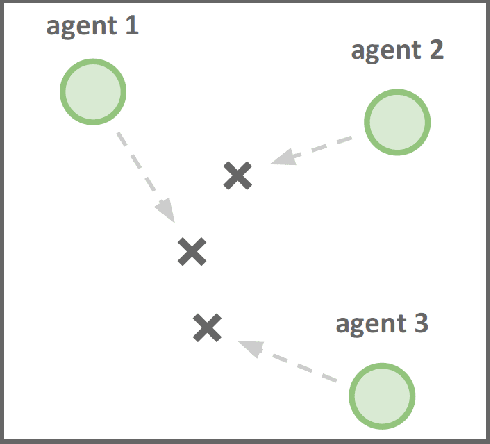

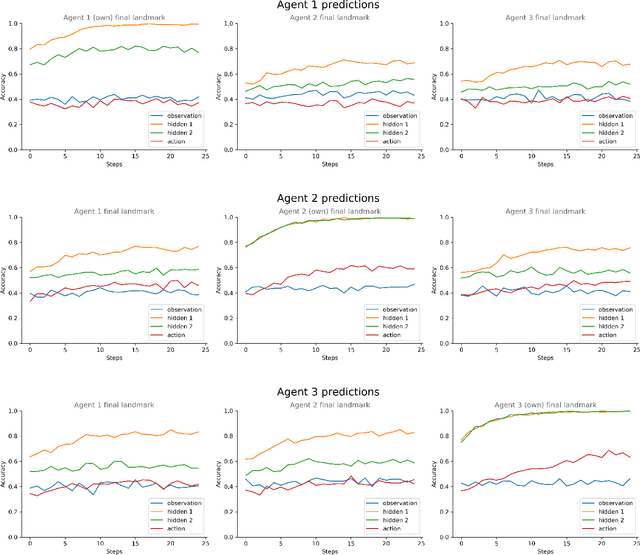

Abstract:Inferring other agents' mental states such as their knowledge, beliefs and intentions is thought to be essential for effective interactions with other agents. Recently, multiagent systems trained via deep reinforcement learning have been shown to succeed in solving different tasks, but it remains unclear how each agent modeled or represented other agents in their environment. In this work we test whether deep reinforcement learning agents explicitly represent other agents' intentions (their specific aims or goals) during a task in which the agents had to coordinate the covering of different spots in a 2D environment. In particular, we tracked over time the performance of a linear decoder trained to predict the final goal of all agents from the hidden state of each agent's neural network controller. We observed that the hidden layers of agents represented explicit information about other agents' goals, i.e. the target landmark they ended up covering. We also performed a series of experiments, in which some agents were replaced by others with fixed goals, to test the level of generalization of the trained agents. We noticed that during the training phase the agents developed a differential preference for each goal, which hindered generalization. To alleviate the above problem, we propose simple changes to the MADDPG training algorithm which leads to better generalization against unseen agents. We believe that training protocols promoting more active intention reading mechanisms, e.g. by preventing simple symmetry-breaking solutions, is a promising direction towards achieving a more robust generalization in different cooperative and competitive tasks.
Teacher-Student Curriculum Learning
Nov 29, 2017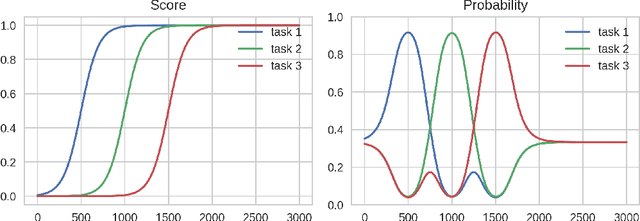
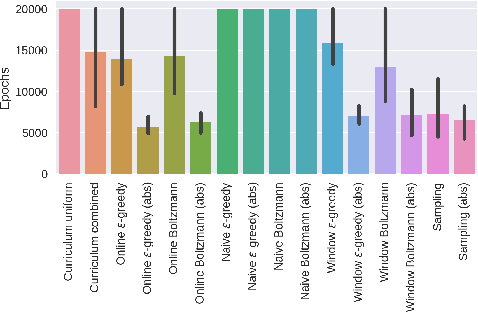
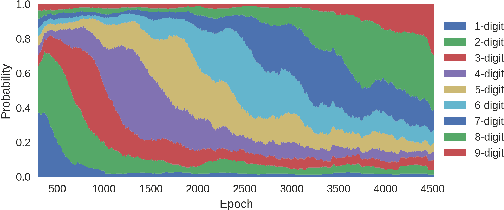
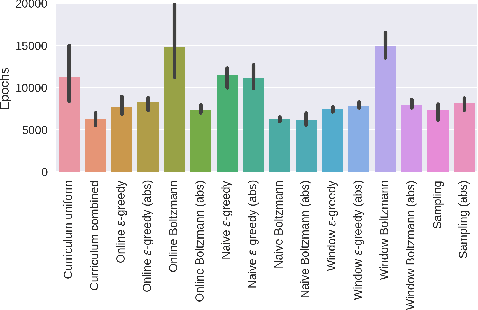
Abstract:We propose Teacher-Student Curriculum Learning (TSCL), a framework for automatic curriculum learning, where the Student tries to learn a complex task and the Teacher automatically chooses subtasks from a given set for the Student to train on. We describe a family of Teacher algorithms that rely on the intuition that the Student should practice more those tasks on which it makes the fastest progress, i.e. where the slope of the learning curve is highest. In addition, the Teacher algorithms address the problem of forgetting by also choosing tasks where the Student's performance is getting worse. We demonstrate that TSCL matches or surpasses the results of carefully hand-crafted curricula in two tasks: addition of decimal numbers with LSTM and navigation in Minecraft. Using our automatically generated curriculum enabled to solve a Minecraft maze that could not be solved at all when training directly on solving the maze, and the learning was an order of magnitude faster than uniform sampling of subtasks.
Multiagent Cooperation and Competition with Deep Reinforcement Learning
Nov 27, 2015



Abstract:Multiagent systems appear in most social, economical, and political situations. In the present work we extend the Deep Q-Learning Network architecture proposed by Google DeepMind to multiagent environments and investigate how two agents controlled by independent Deep Q-Networks interact in the classic videogame Pong. By manipulating the classical rewarding scheme of Pong we demonstrate how competitive and collaborative behaviors emerge. Competitive agents learn to play and score efficiently. Agents trained under collaborative rewarding schemes find an optimal strategy to keep the ball in the game as long as possible. We also describe the progression from competitive to collaborative behavior. The present work demonstrates that Deep Q-Networks can become a practical tool for studying the decentralized learning of multiagent systems living in highly complex environments.
 Add to Chrome
Add to Chrome Add to Firefox
Add to Firefox Add to Edge
Add to Edge